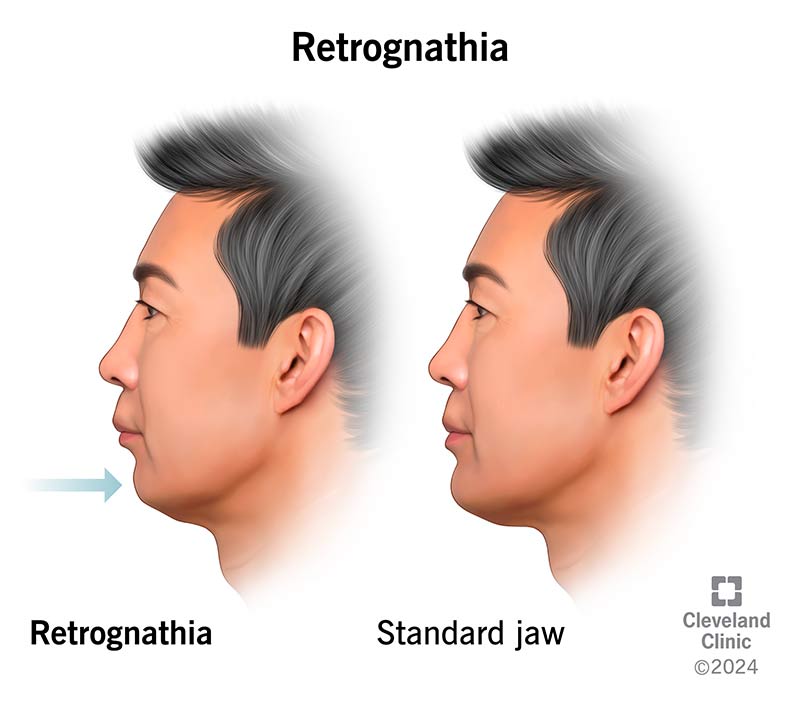Retrognathia is the medical term for a receding chin. It’s when your lower jaw sits further back than it should. While not harmful on its own, a receding chin can cause issues like TMJ disorder and obstructive sleep apnea. In babies, retrognathia can interfere with feeding. Severe cases may require treatment with orthodontics, jaw surgery or both.
Advertisement
Cleveland Clinic is a non-profit academic medical center. Advertising on our site helps support our mission. We do not endorse non-Cleveland Clinic products or services. Policy

Retrognathia (reh-trow-NA-thee-uh) refers to a receding chin where your lower jaw sits much further back than your upper jaw. It’s a common type of malocclusion where your upper and lower teeth don’t fit together the way they should. It’s like when you try to fit two puzzle pieces together, but they don’t match up. It can make your chin look smaller, and it might cause issues with biting and chewing.
Advertisement
Cleveland Clinic is a non-profit academic medical center. Advertising on our site helps support our mission. We do not endorse non-Cleveland Clinic products or services. Policy
Other names for this condition include mandibular retrognathia and retrognathism.
There are two types of retrognathia:
Retrognathia symptoms include:
If you have mild retrognathia, you may not have noticeable symptoms.
Causes of retrognathism include:
Untreated retrognathism can lead to complications like:
Advertisement
Healthcare providers usually diagnose retrognathia during a physical exam. They may also want to take a cephalometric X-ray (a type of dental X-ray). It shows a side view of your entire head. Your healthcare provider can use this imaging test to see how your upper and lower jaws fit together.
Your baby’s pediatrician might notice retrognathia. But it’s not diagnosed until childhood or adolescence in many cases.
It depends on the severity of your symptoms and whether retrognathia causes any additional health issues. From least to most invasive, retrognathia treatments include:
Many people with retrognathia need a combination of jaw surgery and orthodontics. Ask your healthcare provider what’s best for your situation.
The following treatments don’t address retrognathia directly. But they may help manage complications like sleep apnea and speech difficulties:
Retrognathia isn’t a dangerous or life-threatening condition. But it can cause pain, breathing difficulties and other complications in some cases.
If you have mild retrognathia, you might not need treatment. More severe cases require orthodontics or surgery. Your healthcare provider can tell you what to expect in your situation.
You usually can’t prevent retrognathia — especially if genetics caused it. But early treatment can lessen its severity and reduce your risk for worsening symptoms.
If your child sucks their thumb or thrusts their tongue, try to reverse those habits sooner rather than later. If you need suggestions on how to do this, talk to your child’s dentist or pediatrician.
Let your healthcare provider know if you develop:
These things may point to retrognathia or a similar condition.
Here are some questions you might want to ask your healthcare provider:
Advertisement
Retrognathia is different from micrognathia. A person with micrognathia has a small chin. Someone with retrognathia has an average-sized chin, but their jaw is in the wrong position. Retrognathia is also different from an overbite, where your upper teeth overlap your lower teeth more than they should.
You might think of your receding chin as strictly a cosmetic issue. While that may feel true to you, it’s important to know that it can cause health issues in some cases. Treatment may bring your jaw back into alignment so your teeth fit together the way they should. If you’re worried you might have retrognathia, don’t hesitate to talk to your healthcare provider. They’re here to help you understand exactly what’s happening and explore the best options with you.
Advertisement
If your child has conditions affecting their ears, nose or throat, you need experts on your side. Cleveland Clinic Children’s pediatric otolaryngologists can help.

Last reviewed on 01/15/2025.
Learn more about the Health Library and our editorial process.